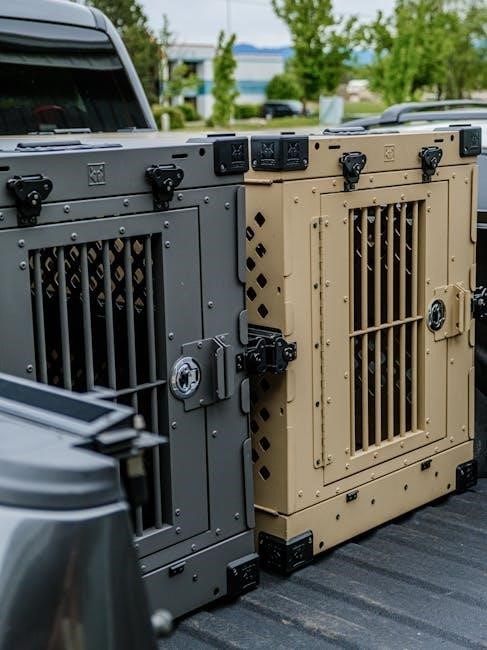
carrier apu manual
This manual provides essential guidance for operating, maintaining, and troubleshooting Carrier Auxiliary Power Units (APUs), covering models like Aspen, ComfortPro, and PC6000.
1.1 Overview of the Carrier Auxiliary Power Unit (APU)
The Carrier Auxiliary Power Unit (APU) is a critical component designed to provide reliable power for heating, cooling, and electrical systems in vehicles. Models like Aspen, ComfortPro, and PC6000 offer advanced features, including battery charging, shore power integration, and quiet operation. This unit ensures comfort and functionality, making it essential for modern vehicles.
1.2 Importance of the Manual for Operators and Technicians
This manual serves as an essential resource for operators and technicians, detailing operation, maintenance, and troubleshooting procedures. It ensures safe and efficient use of the APU, providing step-by-step guides and technical specifications. Adhering to the manual’s instructions helps maintain optimal performance, prevents damage, and ensures compliance with safety standards and manufacturer recommendations.
Models and Specifications of Carrier APU
Carrier offers various APU models, including the Aspen, ComfortPro series (200INT, 210STA, 220PWR, 230SKY), and PC6000, each featuring unique specifications and capabilities for diverse applications.
2.1 Carrier Aspen APU Model and Features
The Carrier Aspen APU is a portable auxiliary power unit designed for efficient performance, featuring a compact design, low emissions, and quiet operation. It includes a compressor, condenser fan, heat exchanger, and four rechargeable batteries. The Aspen model is ideal for providing reliable power and climate control in various vehicle applications, ensuring optimal comfort and energy efficiency.
2.2 Carrier ComfortPro APU Series (200INT, 210STA, 220PWR, 230SKY)
The ComfortPro APU series, including 200INT, 210STA, 220PWR, and 230SKY, offers reliable auxiliary power solutions. These models are designed for diesel-powered performance, featuring compact designs and versatility for various vehicle applications. They provide consistent power supply, ensuring comfort and efficiency in heating, cooling, and battery charging systems for diverse operational needs.
2.3 Carrier PC6000 APU Model Specifications
The Carrier PC6000 APU is a high-performance auxiliary power unit designed for heavy-duty applications. It features a robust design, advanced fuel efficiency, and quiet operation. With a power supply capacity of up to 6000 watts, it supports multiple systems, including heating, cooling, and battery charging, making it ideal for extended use in various environments.

Installation and Initial Setup
Proper installation and initial setup are crucial for optimal APU performance. Ensure correct mounting, power connections, and configuration of settings as outlined in the manual for smooth operation.
3.1 Step-by-Step Installation Guide for Carrier APU
Plan the installation site, ensuring proper ventilation and accessibility. Mount the APU securely on the vehicle’s frame rail. Connect electrical and fuel systems as per specifications. Install the shore power kit if required. Configure settings using the control panel. Test all functions to ensure proper operation. Consult a professional for complex setups.
3.2 Initial Setup and Configuration Requirements
Configure the control panel settings according to your needs. Ensure proper electrical and fuel connections are secure. Test the APU’s start/stop functionality and verify battery charge levels. Review the manual for specific configuration options. Conduct a trial run to ensure all systems operate smoothly. Adjust settings as needed for optimal performance.

Operation and Control of Carrier APU
Start and stop the APU using the Driver Control Panel (DCP). Switch between manual and automatic modes for efficient operation. Monitor and adjust settings as needed.
4.1 Starting and Stopping the APU
Initiate APU startup using the On/Off button on the Driver Control Panel (DCP). Ensure all pre-start checks are completed. To stop, press the Off button and allow the unit to cool. Always refer to the manual for specific procedures to ensure safe and proper operation.
4.2 Manual and Automatic Operation Modes
Manual mode allows drivers to control APU functions like fan, heater, and AC using the DCP. Automatic mode enables hands-free operation, with the system adjusting settings for optimal performance. Switching modes is done via the DCP, ensuring flexibility and efficiency based on operational needs.
4.3 Using the Driver Control Panel (DCP) for APU Management
The DCP enables intuitive control of APU functions, including starting/stopping the unit, adjusting fan, heater, and AC settings. Operators can switch between manual and automatic modes, monitor system status, and access diagnostic information. The DCP also supports optional Shore Power integration for extended operational flexibility, ensuring seamless management of the APU from the driver’s seat.

Maintenance and Service Guidelines
Regular maintenance ensures optimal APU performance and longevity. Follow recommended service intervals, inspect electrical and fuel systems, and use genuine Carrier parts for reliable operation and efficiency.
5.1 Routine Maintenance Tasks for Optimal Performance
Regularly inspect and clean air filters, check battery connections, ensure proper coolant levels, and monitor belt wear. Lubricate moving parts and replace filters as specified in the manual to maintain efficiency and prevent unexpected shutdowns.
5.2 Service Intervals and Recommended Procedures
Follow the recommended service schedule, including filter replacements every 500 hours and full system checks every 1,000 hours. Refer to the manual for detailed procedures, ensuring all parts are genuine and compatible. Regular inspections and timely replacements prevent downtime and ensure optimal performance.
5.3 Troubleshooting Common APU Issues
Common issues include unexpected shutdowns, battery drainage, and heating/cooling malfunctions. Check error codes, ensure proper fuel levels, and inspect electrical connections. For battery issues, verify charging systems and alternator function. Address cooling problems by cleaning air filters and ensuring proper airflow. Refer to the manual for specific diagnostic steps and solutions.
Technical Specifications and Requirements
The Carrier APU requires specific battery, fuel, and electrical specifications to function optimally. Ensure compliance with operational limits and environmental conditions for reliable performance and longevity of the unit.
6.1 Electrical and Fuel Requirements for Carrier APU
The Carrier APU requires a 12V or 24V DC power supply for operation. It uses diesel fuel, with a minimum capacity of 10 gallons. Ensure the battery is fully charged and connected properly. The APU also supports optional shore power for reduced fuel consumption during stationary operations. Always refer to the manual for specific voltage and fuel recommendations to ensure safe and efficient performance. Proper electrical connections and fuel quality are crucial for optimal functionality and longevity of the unit. Adhere to the specified guidelines to avoid any operational issues or damage to the system.
6.2 Battery and Charging System Specifications
The Carrier APU typically uses a 12V or 24V deep-cycle battery, depending on the model. The battery powers the APU’s electrical systems and ensures reliable startup. Charging occurs via the vehicle’s alternator or an optional shore power connection. Regular voltage checks and terminal inspections are recommended to maintain optimal performance and prevent power-related issues.
6.3 Environmental and Operational Limits
The Carrier APU operates effectively within temperatures of -20°F to 120°F (-29°C to 49°C) and humidity up to 80%. It is designed for altitudes up to 8,000 feet without derating. Ensure proper ventilation to avoid overheating. Operational limits include maintaining stable voltage and using approved fuel types to ensure efficient performance and longevity of the unit.

Safety Precautions and Guidelines
Adhere to safety guidelines when handling fuel and electrical components. Avoid overheating and ensure proper ventilation. Follow emergency shutdown procedures and use genuine Carrier parts for reliability.
7.1 General Safety Guidelines for APU Operation
Ensure proper ventilation to prevent carbon monoxide buildup. Avoid overheating by maintaining clear surroundings. Keep flammable materials away and follow shutdown procedures during emergencies. Always use genuine Carrier parts for optimal performance and safety compliance.
7.2 Handling Fuel and Electrical Components Safely
Always disconnect power before servicing. Use protective gear when handling fuel and electrical systems. Avoid sparks near fuel sources. Follow proper grounding procedures to prevent electrical hazards. Ensure all connections are secure and meet Carrier specifications for safe operation.
7.3 Emergency Shutdown Procedures
In case of an emergency, switch off the APU power immediately. Activate the emergency stop button on the control panel. Ensure all fuel lines are closed and electrical connections are disconnected. Allow the unit to cool down before restarting. Always follow the manual’s specific shutdown instructions for your APU model.
Advanced Features and Customization
This section explores optional enhancements like the Shore Power kit for extended use and customization options, allowing tailored settings to meet specific operational needs and preferences.
8.1 Optional Shore Power Kit for Extended Use
The Shore Power kit allows the APU to charge batteries and power systems when connected to an external electrical source, reducing engine wear and fuel consumption. This feature is ideal for extended stationary operations, ensuring reliability and efficiency while minimizing operational costs and environmental impact.
8.2 Customizing APU Settings for Specific Needs
Customize APU settings using the Driver Control Panel (DCP) to tailor operations for specific requirements. Adjust temperature setpoints, fan speeds, and power management to optimize performance. This feature allows users to adapt the APU to their unique needs, enhancing comfort and efficiency while reducing energy consumption and operational costs.
8.3 Integration with Other Vehicle Systems
The Carrier APU seamlessly integrates with other vehicle systems, such as shore power kits, battery charging, and cabin control units. This integration enhances functionality, allowing for automatic operation and synchronized performance with the vehicle’s electrical and HVAC systems, ensuring efficient energy use and optimal comfort during operation.

Troubleshooting Common Issues
This section addresses frequent APU problems, such as unexpected shutdowns, battery issues, and heating or cooling malfunctions, providing practical solutions and diagnostic steps for effective resolution.
9.1 Diagnosing APU Shutdown Problems
Identify shutdown causes by checking low battery voltage, overheat conditions, or fuel issues. Inspect for blockages in air intakes or exhaust. Verify proper fuel levels and connections. Review error codes on the control panel for specific fault indicators. Consult the manual for detailed diagnostic procedures and solutions to restore operation. Refer to page 19 for additional guidance.
9.2 Resolving Battery and Charging Issues
Check battery terminals for corrosion and secure connections. Ensure the alternator is charging correctly during engine operation. Test battery voltage using a multimeter; replace if below 12V. If using shore power, verify the connection is stable. Refer to the manual’s troubleshooting section for specific steps to address charging system malfunctions effectively. Always use genuine Carrier parts for replacements.
9.3 Addressing Heating and Cooling Malfunctions
Check for blockages in condenser and evaporator coils. Ensure proper refrigerant levels and inspect for leaks. Test thermostat and temperature sensors for accuracy. Verify fan operation and replace faulty switches. Consult the manual for model-specific troubleshooting steps, such as those for ComfortPro or Aspen APU systems, to resolve malfunctions efficiently.
This manual provides comprehensive guidance for Carrier APU operation, maintenance, and troubleshooting. For further assistance, refer to Carrier’s official website or contact a certified Carrier Transicold dealer.
10.1 Summary of Key Points in the Manual
This manual covers essential aspects of Carrier APU operation, including installation, maintenance, and troubleshooting. It highlights key features of models like Aspen, ComfortPro, and PC6000, emphasizing safety, proper usage, and service intervals. Referencing additional resources like official Carrier websites or certified dealers ensures comprehensive support for optimal APU performance and longevity.
10.2 Where to Find Additional Documentation and Support
Additional documentation and support for Carrier APU models, including ComfortPro and PC6000, can be found on the official Carrier Transicold website or through authorized dealers. Visit the product literature section or contact local experts for comprehensive guides, service manuals, and troubleshooting resources to ensure optimal performance and compliance with manufacturer recommendations.
Related Posts

taylor indoor/outdoor thermometer manual 1502
Download the Taylor indoor/outdoor thermometer 1502 manual for easy setup and accurate temperature readings. Get the most out of your device with our comprehensive guide.

2014 ford f 150 owners manual
Get the free 2014 Ford F-150 owner’s manual. Comprehensive guide with maintenance tips, features, and repair info. Download now!

xnx universal transmitter user manual
Get the XNX Universal Transmitter User Manual for setup, operation, and troubleshooting. Download the comprehensive guide now!